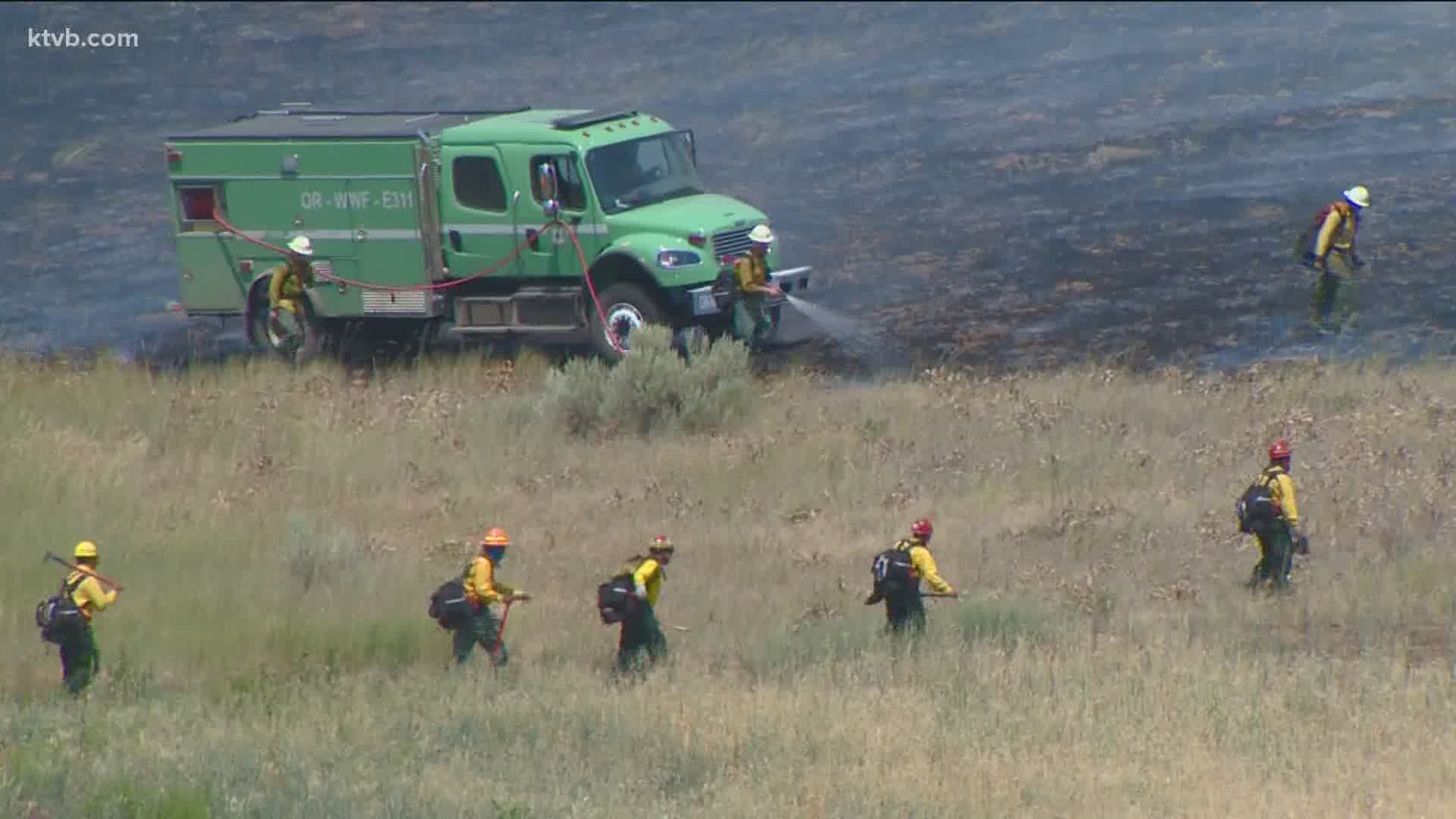BOISE, Idaho — Wildland firefighters are getting ready for another potentially busy fire season.
Our wildfire seasons are getting longer and the fires are getting bigger. The U.S. Forest Service says the seasons now average about 70 days longer than they were in the 1970s.
Every year brave and dedicated men and women put themselves in danger to keep us safe. The mission of wildland firefighters is to protect lives, property and resources. But why do they do this dangerous and difficult job?
As part of Wildfire Awareness Week on KTVB, we caught up with three of the thousands of wildland firefighters to get an idea of their mentality. What makes them tick? We learned it takes courage, conviction, camaraderie, conditioning and a whole lot of calories.
Boise BLM Engine Captain Bryce Alexander started fighting wildfires 27 years ago as a way to pay for college.
"Then I got the bug and made a career out of it," Alexander said.
Boise BLM Helitack Squad Leader Nathan Weiner got into firefighting for the chance to work outdoors with good people and travel the western U.S.
"But ultimately getting the chance to serve your community and protect natural resources, property and all that," Weiner said.
And Great Basin Smokejumper Martha Schoppe jumped in for the challenge.
"My vehicle is an airplane, and I get to parachute into fire areas," Schoppe said. " I love being a smokejumper. You're independent. You have challenges. We're a smaller group. So we generally jump into a fire either two, four, six or eight of us."
Right now, all three are refreshing their knowledge, refining their skills and readying their bodies for what could be a grueling summer.
"The training is huge. Training, training, training," Alexander said.
"A lot of physical training to get the crew and everybody up to speed is a big part of it, and going through as many scenarios as we can to be prepped for the upcoming fire season," Weiner said.
"All of us (smokejumpers) get 5 to 15 jumps in the spring before we're jumping into fire areas," Schoppe said.
Because they will soon be flying...
"Once we get a good initial size-up of the fire we'll land the helicopter, get all of our firefighters and tools off the aircraft, then hook up the bucket and go to work," Weiner said.
Driving and walking...
"You know, the fire going. You're seeing all the pieces, parts, the radios and everything going at once," Alexander said. "It's an adrenaline thing."
And jumping into active fire zones.
"We cock back and then just cannonball out of the plane," Schoppe said demonstrating the smokejumpers' jumping technique from a plane parked on the tarmac outside the National Interagency Fire Center headquarters at the Boise Airport.
She freefalls with no frivolous thoughts.
"It's like jump thousand, look thousand, reach thousand, wait thousand, pull thousand. That's when you pull (the parachute cord). Every single time is the same," Schoppe said.
The routine helps ensure safety. About three minutes after pulling the ripcord, she and her small team of smokejumpers are on the ground.
"I actually enjoy the fires that are out in the middle of nowhere," Schoppe said. "Those are low stress. There's bears and moose. That's great."
On the other hand.
"When there's houses around and engines rolling in and people getting all riled up, those are the challenging ones for me."
They've all found themselves in high-stress situations where their training really kicks in.
"We had just completed a burnout and we were securing it, and the winds picked up and blew the fire right at us," Alexander said. "And it was instantaneous, get in the black."
The black. That's the area already burned.
"Boom. You're right there. You're safe," Alexander said.
"There's a number of instances where you have extreme fire behavior and you need to take a step back and reevaluate what your mission set is," Weiner said.
Dangerous. Yes. Taxing, too.
"There's a big physical component to the job, obviously. Long hours, stressful conditions whether it's temperature, terrain, things like that," Weiner said.
"The heat and carrying a lot of weight and steep terrain and long days, 16-hour days, plus," Schoppe said.
She also said her small crew of up to eight smokejumpers is often very isolated in the middle of nowhere. She says they can usually get a ride back to civilization on a helicopter. But sometimes they have to walk out with all of their gear, and they each carry 135 pounds of it.
So, while the fire chews up fuel, they need to be chewing up fuel, too.
"I'd say on those tough, really physical days of 16 hour shifts or longer 4,000 to 6,000 calories at least to keep things going," Weiner said.
"I want to say an MRE (Meal Ready to Eat) is 2,000 or more calories, if you eat the whole thing," Alexander said. "Sometimes you don't have time to eat the whole thing."
"I know I carry at least 5,000 calories in my pack," Schoppe said. "An MRE is a whole pile anyways."
Fuel to carry out the mission: Saving Lives. Saving Property. Saving natural resources. It's why they do what they do. That and this.
"Just the camaraderie, going through those challenges with fellow smokejumpers," Schoppe said.
"A great group of folks, good camaraderie," Weiner said.
"The excitement and the camaraderie of this job. It's tough to describe it unless you're part of it," Alexander said.
Being part of a small, tight-knit community built on trust and common ground.
Watch more on wildfires in the West:
See all of our latest coverage in our YouTube playlist:

